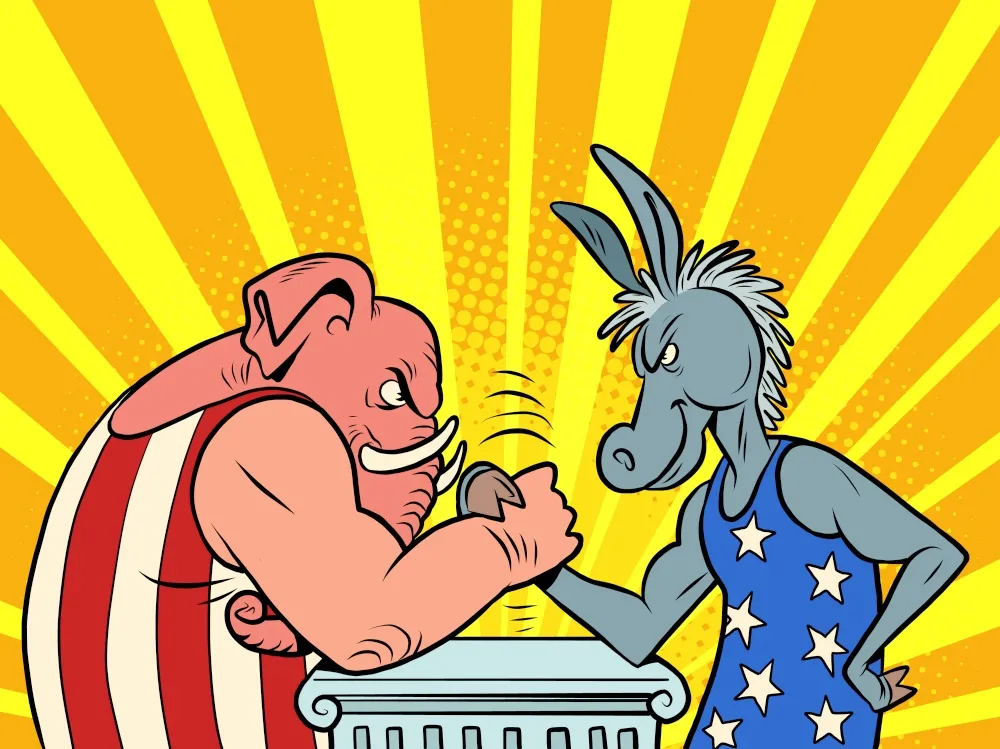The perennial dance between the president and Congress over the budget and raising America’s debt ceiling is a widely reported, but much-ignored, event. This time around it shouldn’t be. Even as our national debt soars, Americans are split over how serious the problem is, the latest I&I/TIPP Poll shows. Meanwhile, a government shutdown, or even possibly default, looms.
At last official count, federal debt totaled about $31.5 trillion. Looked at from a different perspective, $31.5 trillion means each American household is now responsible for roughly $237,500 in U.S. debt.
And it’s getting bigger fast, posing a threat to both the economy and to the financial system. If Congress and President Joe Biden can’t make a deal soon, a government shutdown, or worse, possible default, loom.
How does the public feel about this? The online I&I/TIPP Poll for April, taken from March 29-31 from 1,365 Americans across the country, asked the following question: “Some say that the debt is not sustainable. Others say that the debt is manageable relative to the size of the American economy. Which is closer to your viewpoint?”
Overall, voters saying the debt is “not sustainable” totaled 48%, a plurality, compared to those who called the debt “manageable relative to the size of the economy” at 35%. (The poll’s margin of error is +/-2.8 percentage points.)

The political breakdown, however, is telling and perhaps explains why the debt debate each year gets more and more divisive and angry: Republicans (74%) and independents (50%) overwhelmingly call the debt unsustainable, compared to Democrats at just 32%. Only 14% of Republicans and 28% of independents call the debt “manageable,” versus 51% of Democrats who do.

This huge split between Democrats on one side, and Republicans and independents on the other, will make it hard to forge a deal satisfactory to both sides. Failure to do so risks a financial cataclysm.
Other splits show up in the data. Those age 18-24 (43% vs. 43%) and 25-44 (37% vs. 50%) are least likely to say the debt is “not sustainable” vs. “manageable,” while those age 45-64 (56% vs. 24%) and 65+ (54% vs. 21%) are above average in their concern.

Women (50% vs. 25%) are higher in concern than men (46% vs. 44%), and whites (54% vs. 29%) than blacks and Hispanics (34% to 48%).
The point is, given such sizable splits among key electoral demographics, what can be done? On Jan. 19, the debt ceiling was hit, meaning the government has had to play a kind of fiscal shell game to pay its bills.
Talks, though tentative, have already begun.
House Republicans, negotiating with the Biden administration, have put forward a plan to temporarily raise the debt ceiling until May of next year. In exchange for avoiding a possible federal default, they seek caps on federal spending,
“The GOP proposal would call for a cap on either non-defense discretionary spending or overall discretionary spending after paring the federal budget back to 2022 levels,” the Washington Times reported last week.
“The proposal would also claw back unspent COVID-19 funds, block President Biden’s student loan forgiveness plan that is currently tied up in a Supreme Court battle, institute work requirements for social welfare programs and implement the Republican plan to lower energy costs, which passed the House but is expected to languish in the Senate,” the report said.
Will that pass muster with the Biden administration? It doesn’t look like it. The last time Biden and House Speaker Kevin McCarthy met over the debt was in February.
And the White House position has always been: No preconditions. Just raise the debt ceiling.
Fresh from his April 11-14 trip to Ireland, Biden had this to say when asked if he would talk to McCarthy:
“Of course, I’ll speak to him. Show me his budget,” Biden told reporters. “That old expression — ‘show me your budget.’ You know, he — we agreed early on, I’d lay down a budget, which I did on March 9th, and he’d lay down a budget.”
“I don’t know what we’re negotiating if I don’t know what they want,” Biden added.
Sunday was the deadline for Congress to agree on a new budget. For the 20th year in a row, it failed in that responsibility. No surprise there, since the Senate is controlled by the Democrats, and the House by Republicans, who remain far apart in their priorities.
What should be done?
A nonpartisan group of 434 economists, from universities, think tanks and public policy organizations across the country last week issued an urgent message to both Democrats and Republicans in Congress about Biden’s proposed budget, which the group called “unsustainable”:
The Biden Administration believes the solution to America’s economic woes is more federal spending and higher taxes. Having increased federal spending by nearly $5 trillion in its first two years, the Biden administration now proposes additional tax and spending increases totaling $4.7 trillion and $1.9 trillion, respectively.
We urge Congress to reject President Biden’s irresponsible budget proposal and work together to address the country’s short-term needs while also committing itself to take steps toward reducing the federal government’s unsustainable and dangerous fiscal imbalances.
Meanwhile, White House assertions that it will actually cut deficits over the next decade by $3 trillion have been roundly criticized by budget hawks. In fact, projections from the nonpartisan Congressional Budget Office show annual deficits growing from $1.4 trillion this year to $2.7 trillion in 2033, while as a result total federal debt will soar from $32.4 trillion at the end of this year to $52 trillion in 2033.
The IMF’s Fiscal Affairs Director Vitor Gaspar recently told Yahoo Finance that it is clear “that from the viewpoint of medium- and long-term prospects, there is a very strong case for fiscal adjustment in the U.S.”
Of greater concern is what would happen if foreign holders of U.S. government debt suddenly get spooked and start to sell their holdings of U.S. securities.
Officially, foreign treasuries and investors own about $7.6 trillion of U.S. government debt. Bad news here, such as a default on U.S. debt this summer, could spark a run on the dollar and cause interest rates to surge, sending a recessionary shock wave through the U.S. and global economies.
Recent deals among the Russians, Chinese and Saudis to create alternatives to the world’s dollar-based trade are already threatening the dollar’s preeminent position as the No. 1 global currency. A debt-panic might push the dollar to the brink, bringing inflation and perhaps eventually forcing the U.S. to do something it hasn’t had to since before World War II — pay some if not most of its bills in someone else’s currency, a huge disadvantage.
Americans’ complacency about our growing fiscal problems has so far not hurt us too badly. That might not always be the case, however.
I&I/TIPP publishes timely, unique, and informative data each month on topics of public interest. TIPP’s reputation for polling excellence comes from being the most accurate pollster for the past five presidential elections.
Terry Jones is an editor of Issues & Insights. His four decades of journalism experience include serving as national issues editor, economics editor, and editorial page editor for Investor’s Business Daily.
Hey, want to dig deeper? Download data from our store and pay what you can afford!
Like our insights? Show your support by becoming a paid subscriber!
Want to show your appreciation? Donate







